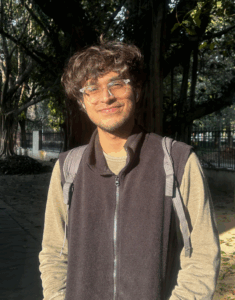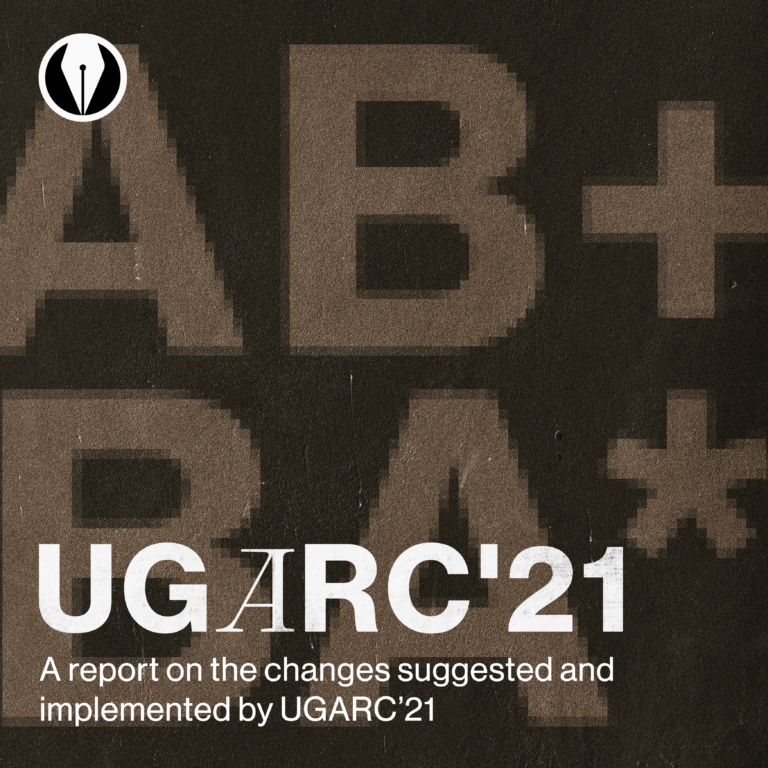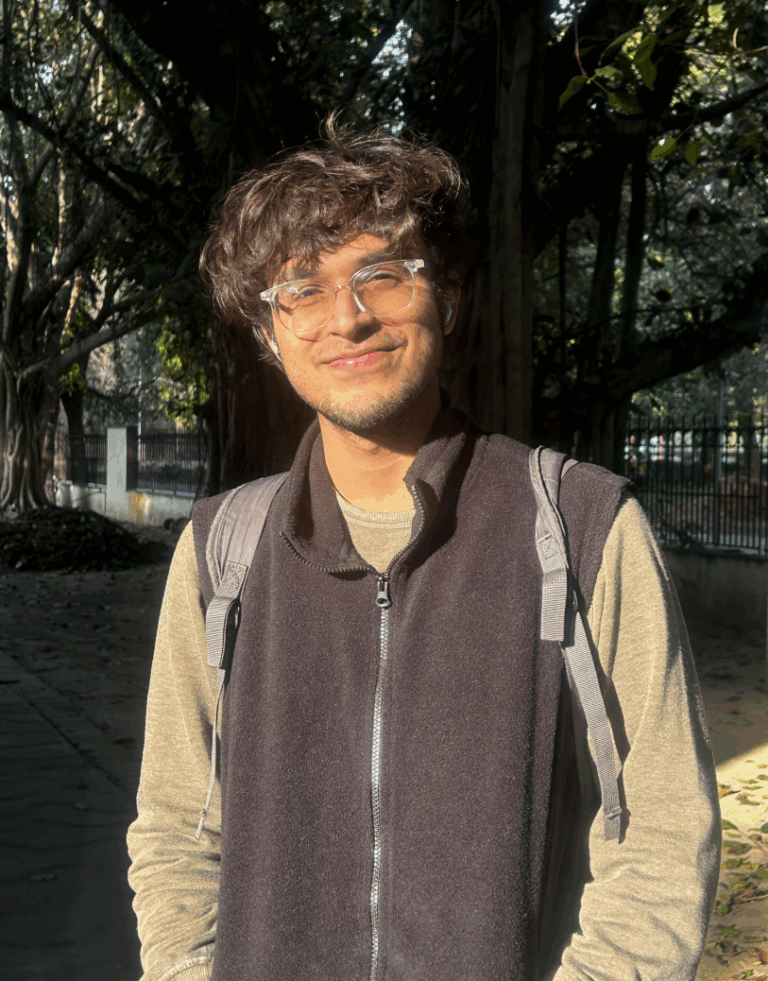Disclaimer: Vox Populi, IIT Kanpur, is the exclusive owner of the information on this website. No part of this content may be duplicated, paraphrased, or interpreted in any other way without written consent from Vox Populi. If you want to reproduce any of the content on this page, please contact our chief editors directly or reach out to us by email at voxpopuli@iitk.ac.in.
INTRODUCTION
The National Institutional Ranking Framework (NIRF) is an initiative by the Government of India to evaluate and rank higher education institutions based on comprehensive criteria. Introduced in 2015 by the Ministry of Human Resource Development (MHRD), now known as the Ministry of Education, it provides students, parents, and policymakers with valuable insights into institutional performance by assessing parameters like teaching, research, employability, and infrastructure. Additionally, NIRF encourages a culture of excellence and innovation, aligns Indian institutions with global standards, and serves as a strategic tool for resource allocation and policy formulation in higher education.
The NIRF rankings for 2024 are released across 16 categories. IIT Kanpur participated in five of these categories: Overall, Engineering, Research, Innovation, and Management. While it secured notable rankings such as 4th in Engineering, 5th Overall, and 7th in Research, there was a notable drop in the Innovation category from 1st in 2023 to 5th in 2024. In Management, IIT Kanpur ranked 29th, reflecting its newer and evolving management programs. This article delves deeper into the performance factors and the reasons behind this shift in ranking.
Disclaimer: For the overall section of the NIRF rankings, we initially interviewed the then DOAA, Prof. Shalabh. However, upon reviewing the draft for verification, he requested that his comments not be published, as his tenure was about to end and advised us to seek the same information from the new DOAA. We then reached out to the new DOAA, Prof. Ashoke De, who redirected us to the Institute’s ranking cell, which operates under the Deputy Director, Prof. Braj Bhushan. Subsequently, we contacted the ranking cell but have not yet received a response.
OVERALL
The Overall category in the NIRF rankings provides a comprehensive assessment of higher education institutions, evaluating their performance across multiple disciplines and functions. It focuses on factors like teaching quality, research output, graduation outcomes, inclusivity, and perception, offering a broad perspective on an institution’s overall excellence.
Teaching, Learning, and Resources
Our analysis of NIRF reports shows that IIT Kanpur is the only top-five IIT with fewer than 300 faculty members having over 15 years of experience. Additionally, the number of female faculty members at IITK is the lowest among IIT Delhi, IIT Bombay, IIT Madras, and IIT Roorkee. Nevertheless, IIT Kanpur maintains the highest faculty-to-student ratio among the top IITs, standing at 0.068, surpassing IIT Madras, IIT Bombay, IIT Roorkee, and IIT Delhi.
We reviewed the online course offerings of IITs via platforms like MOOCs and noted a surge in courses from IIT Kanpur in 2020-21, followed by a decrease the next year.
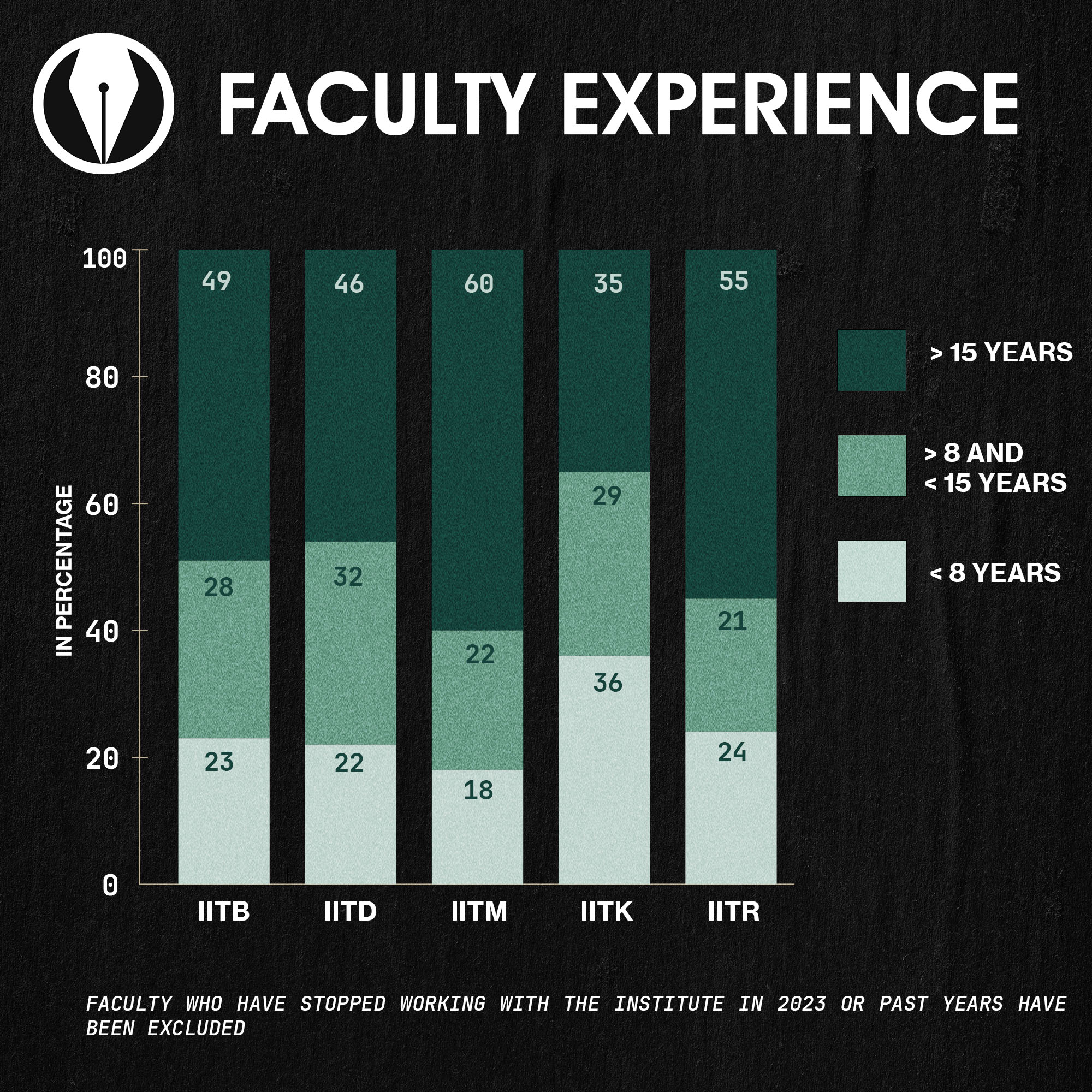
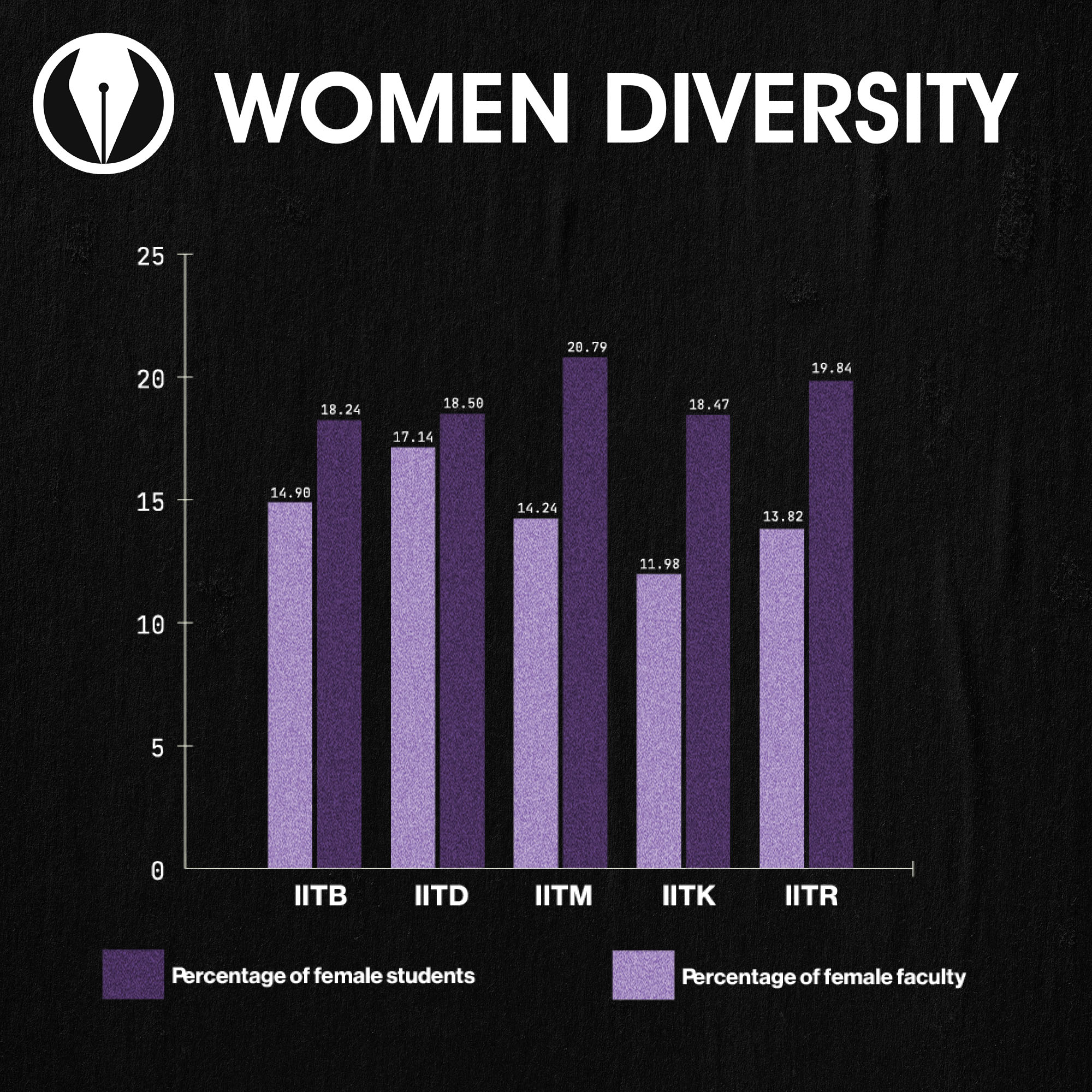
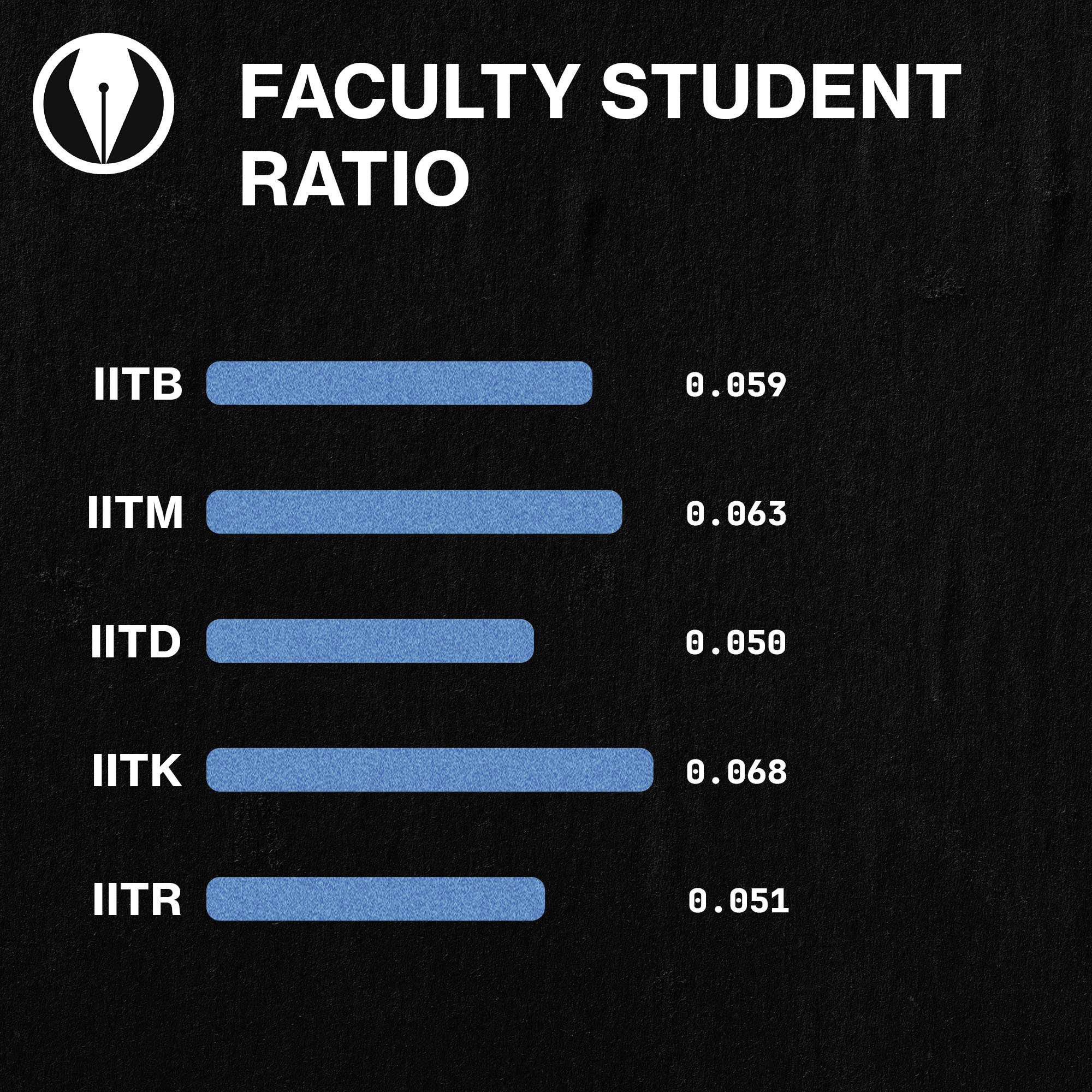
Research and Professional Practice
An intriguing finding related to research funding was that while institutes like IIT Delhi, IIT Bombay, and IIT Madras have each received approx. 326, 408, and 499 crores, respectively, for sponsored research averaged over the past three years, IIT Kanpur has secured only ₹237 crores. Though the number of sponsored research projects has been on the rise, the total funding received has seen a decline.
According to the Deputy Director, Dr Braj Bhushan Singh, there are two primary reasons for lesser research funding. First, the number of faculty at IITK has traditionally been significantly lower than that of other old IITs, which inevitably reduces the number of researchers. Second, there is less focus on writing large projects when a group of faculty members comes together. Over the past few years, the institute has recruited a significant number of faculty and is now encouraging faculty to bid for large projects.
Another observation based on the data submitted by IITs to the NIRF was that IIT Kanpur (IITK) has received the lowest funding for consultancy projects compared to other top IITs. Addressing this, the Deputy Director explained that consultancy projects largely depend on faculty expertise, leading to various project types. Regarding funding, he emphasised that the allocation of funds is influenced by the size of the faculty. The institute’s funding for consultancy projects has almost tripled in the previous three years, as reflected in the submitted data.

Graduation Outcome
After analysing data across various other IITs, it’s evident that the percentage of students pursuing higher studies has dropped significantly over the past three years. However, IIT Kanpur continues to have one of the highest percentages of students pursuing further education, with 24% of undergraduates and 26% of postgraduates opting for advanced studies after graduating from IITK in the academic year 2022-23.
A concerning number that we came across while researching was the average number of full-time PhD students that have graduated in the last three years. This number was 218 in IIT Kanpur, being the second lowest in older IITs, compared to the likes of Bombay, which had the highest, 328.
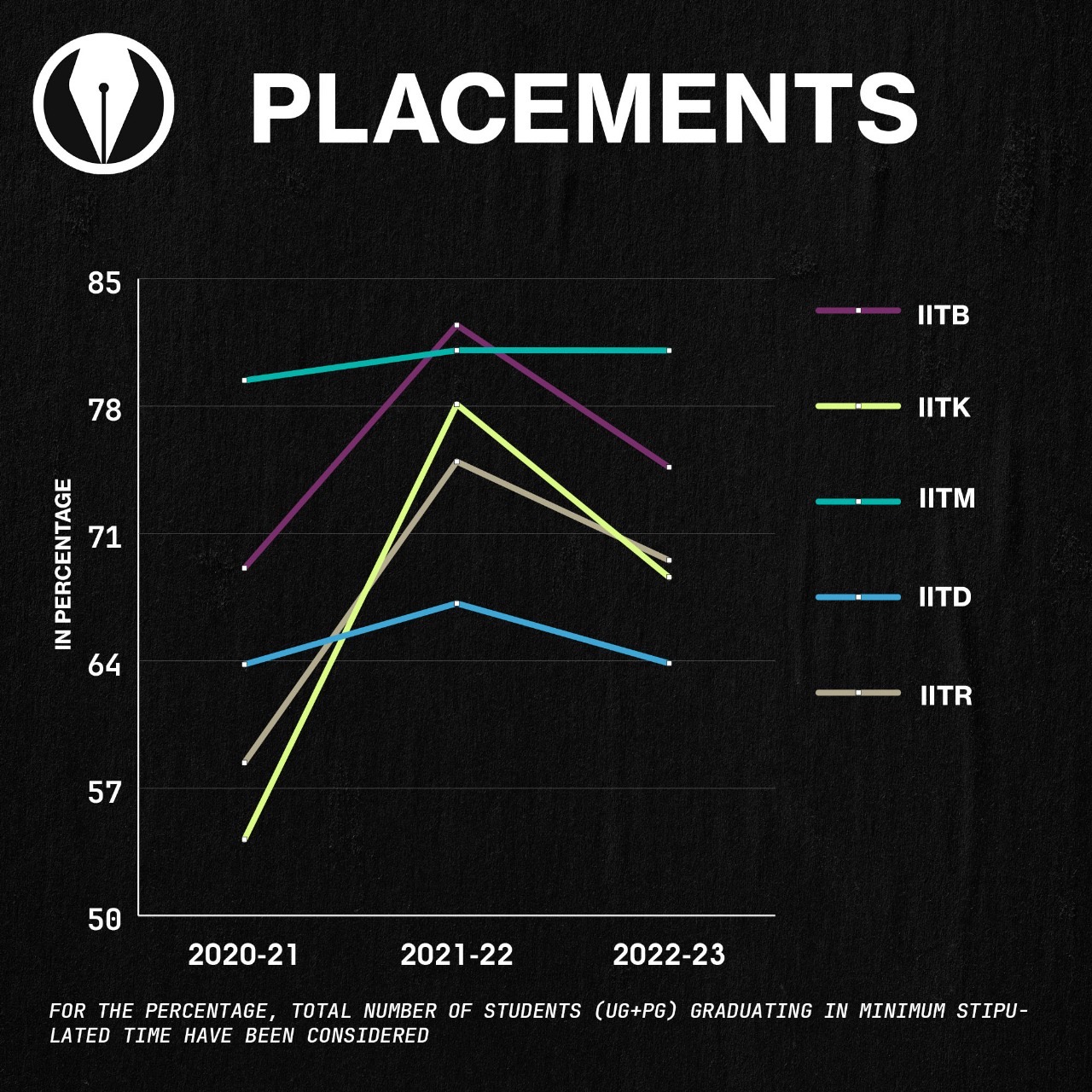
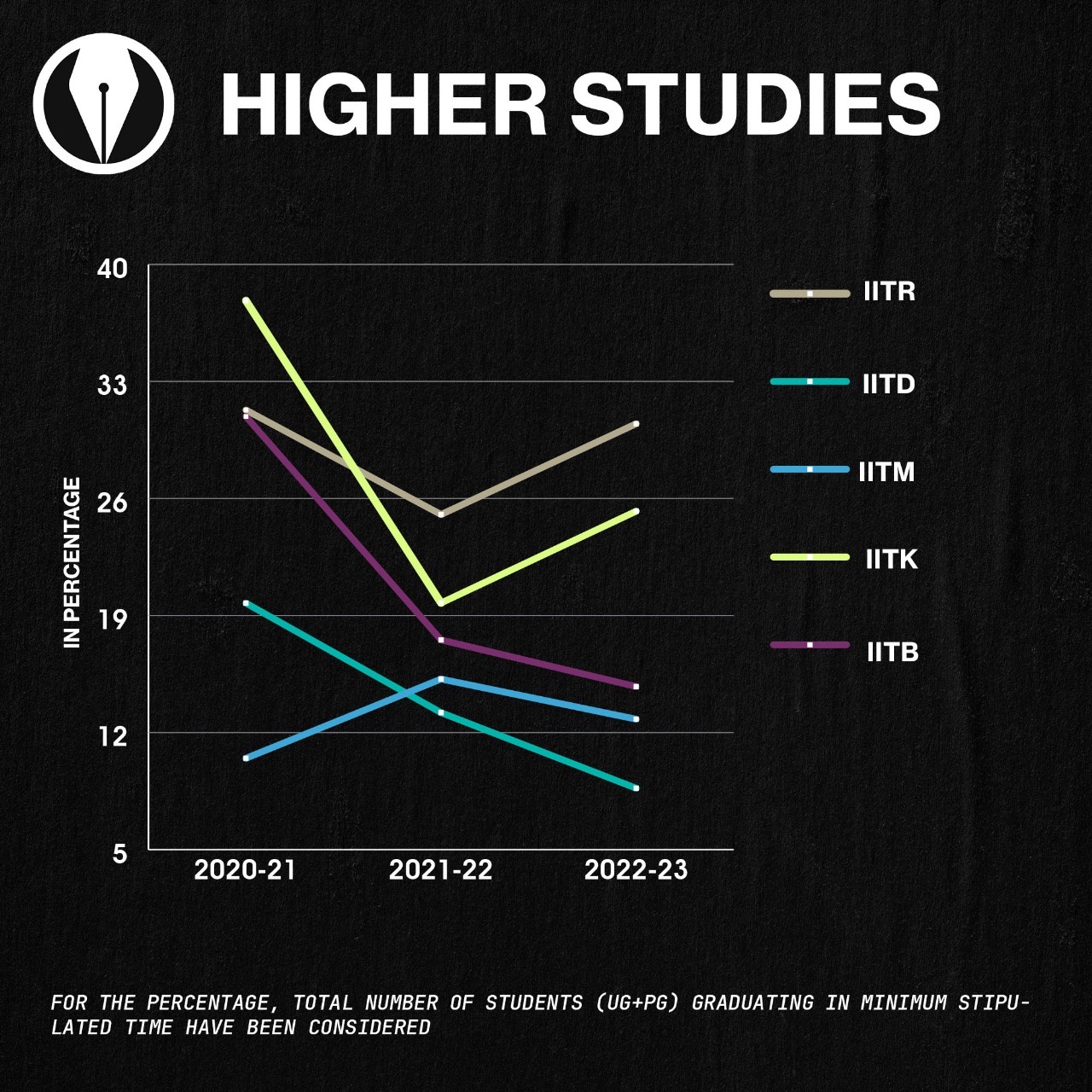
Peer Perception
Peer perception refers to evaluating an institution’s reputation and quality as assessed by other institutions. It involves feedback collected from academic peers (such as faculty members, researchers, and administrators) and industry professionals familiar with the institution. This peer perception score helps NIRF assess how well the institution is regarded in terms of its academic and research excellence, infrastructure, and overall contributions to education and society. This is done through a large-scale survey conducted by NIRF itself, thereby creating a comprehensive list that takes into account various sectors, regions, and other factors. This list is dynamic and is updated periodically. The following infographic shows the scores of top IITs in the peer perception category. IIT Kanpur lacks here as compared to top IITs, scoring significantly lower than IIT Madras, IIT Delhi, and IIT Bombay.

*All scores are out of 100
INNOVATION
Innovation, as a category, was only introduced in 2023 to promote a culture of innovation and entrepreneurship across Indian higher education institutions. NIRF Innovation aims to motivate institutions to focus on research and development that leads to practical solutions and helps build a globally competitive environment for fostering advanced innovations.
In 2024, 808 institutes registered in this category, while only 10 were ranked and published. IIT Kanpur ranked 1st in innovation in the year of the category’s inception but experienced a significant decline to 5th in the latest 2024 edition. To delve deeper into the reasons for this fall, we at Vox Populi interviewed Prof. Amitabha Bandyopadhyay, former professor-in-charge of SIIC, IITK. The following part of the article is primarily based on this interview.
When asked about the rankings, he remarked, “Rankings are a very interesting thing. We are happy when we get a good ranking, and we absolutely don’t like the concept when it’s bad. I am not a fan of these rankings as they don’t capture the parameters that should be captured.” He also shed light on the challenging task of data collection, stating, “The whole process of collecting these data from the startups of the institute is not a trivial task. Last year, when I was involved, I personally had to call them all to get the data as they don’t have any incentive to give the data for NIRF.” He also pointed out that startups have a long gestation period. At IIT Kanpur, the bulk of startups that started on a productive scale happened after 2019. So, the numbers can go up again in upcoming years.
Adding along similar lines, Prof. Braj Bhushan said, “Last year was the first time it was announced, and we did a better job in providing data than many others, resulting in a high rank. This year, others have also provided full data, and the criteria is also different.”
In the Research and Innovation Output section, IITK has 214 patents granted in the past three years (2020 – 22) and a total of 56 crores in innovation grants for the same period. This number is relatively low compared to other top IITs like IIT Bombay and IIT Madras. Prof Bandyopadhyay, while talking about these statistics, explained, “Products/technologies/designs (that are patented) are developed, mostly, with the extramural funds (mostly provided by government funding bodies like DBT DST etc.) which faculty members secure. The 214 patents granted refer to similar products or designs developed using these funds, often called R&D funds. On the other hand, 56 crore rupees refers to the funds IITK received in the past three years to support startups at SIIC through incubator-related activities (from sources like government agencies, corporate donors, and CSR contributions). These two numbers are not correlated in our case. However, since R&D funds earned by faculty can technically be considered innovation grants, I believe some IITs might report these grants, along with direct incubator/startup funding, as the total innovation grant received in a year.”
Another aspect of this is the commercialisation of patents, which measures the ability to earn money through the patents post-granting. IIT Kanpur lacks here as well, with only seven commercialised patents in 2022 and a total of 18 over the past three years. “IIT Kanpur is conservative in its approach compared to other IITs,” he added. “IIT Bombay has a system where they initially give the patent at a lesser price with an agreement to finish the deal after the buyer pays a certain amount after a few years. This is well reflected as they have a combined 77 commercialised patents over the past 3 years. We, however, are not yet ready to have this kind of system. Our location puts us at a disadvantage as well.” Conversely, Prof. Braj Bhushan shared an optimistic view regarding the number of granted patents over the years: “The number of patents granted for IIT Kanpur has increased from 64 in 2021 to 140 in 2023. Also, in a remarkable display of innovation, IIT Kanpur has achieved a significant milestone by achieving an exceptional licensing rate of around 14%.”
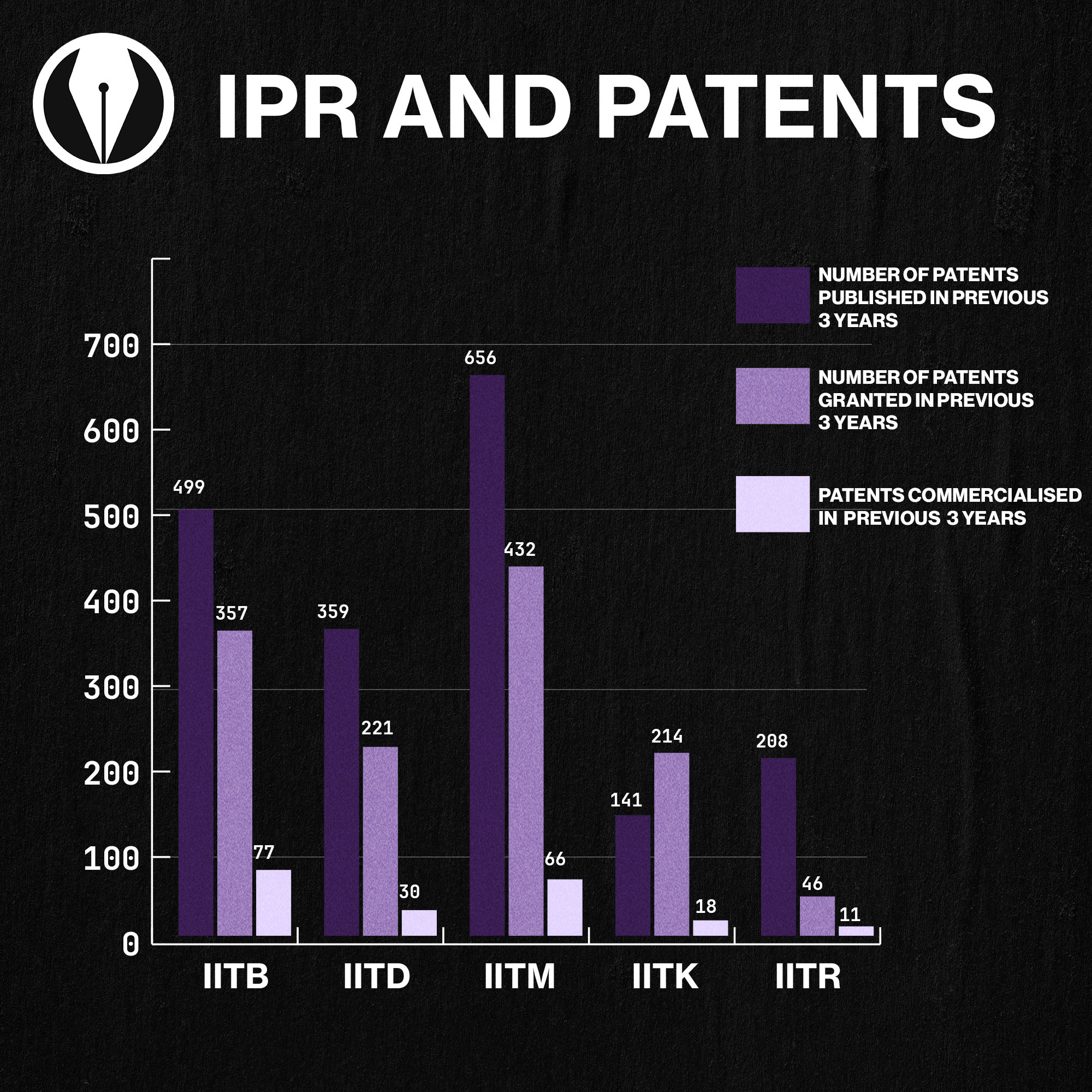
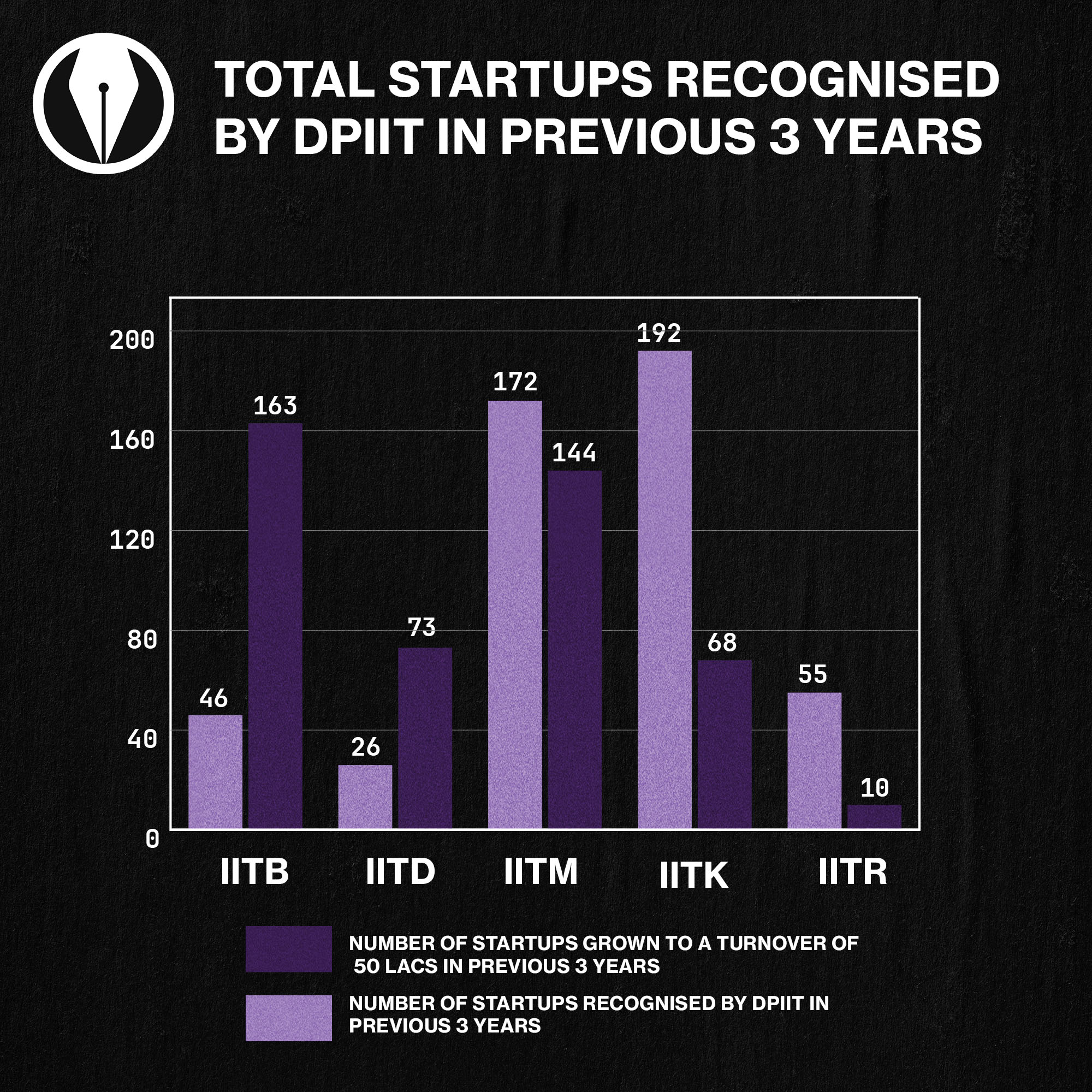
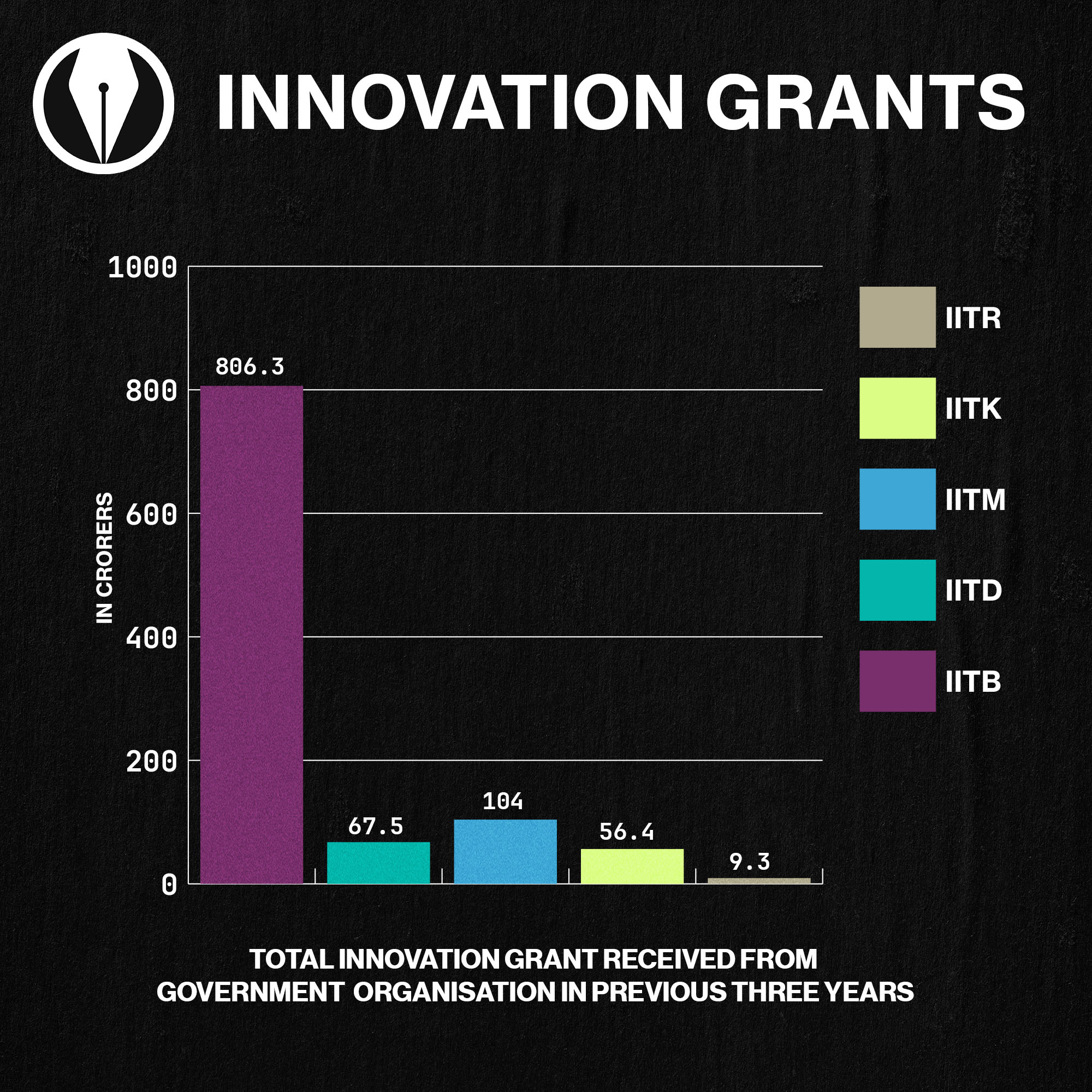
In the financial support for innovation part, VC (Venture capitalist) and FD (Foreign Direct) investments are considered a metric that helps promote startups. The following infographics show the data for top IITs. Prof. Bandyopadhyay expressed skepticism about the accuracy of the submitted data, stating, “I am not sure how reliable the data is for these investments. The scrutiny is very uncertain, and the gap is significant.”
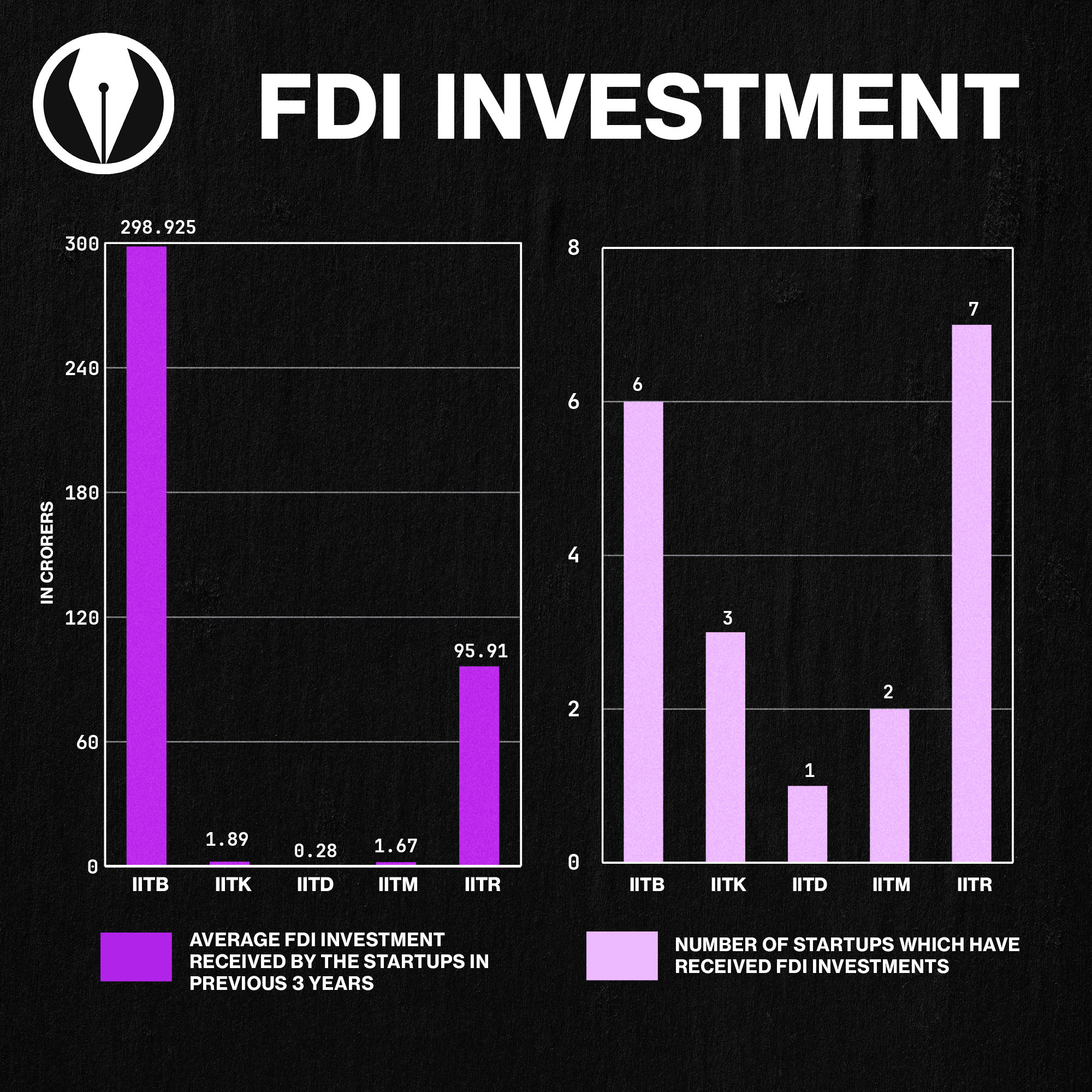
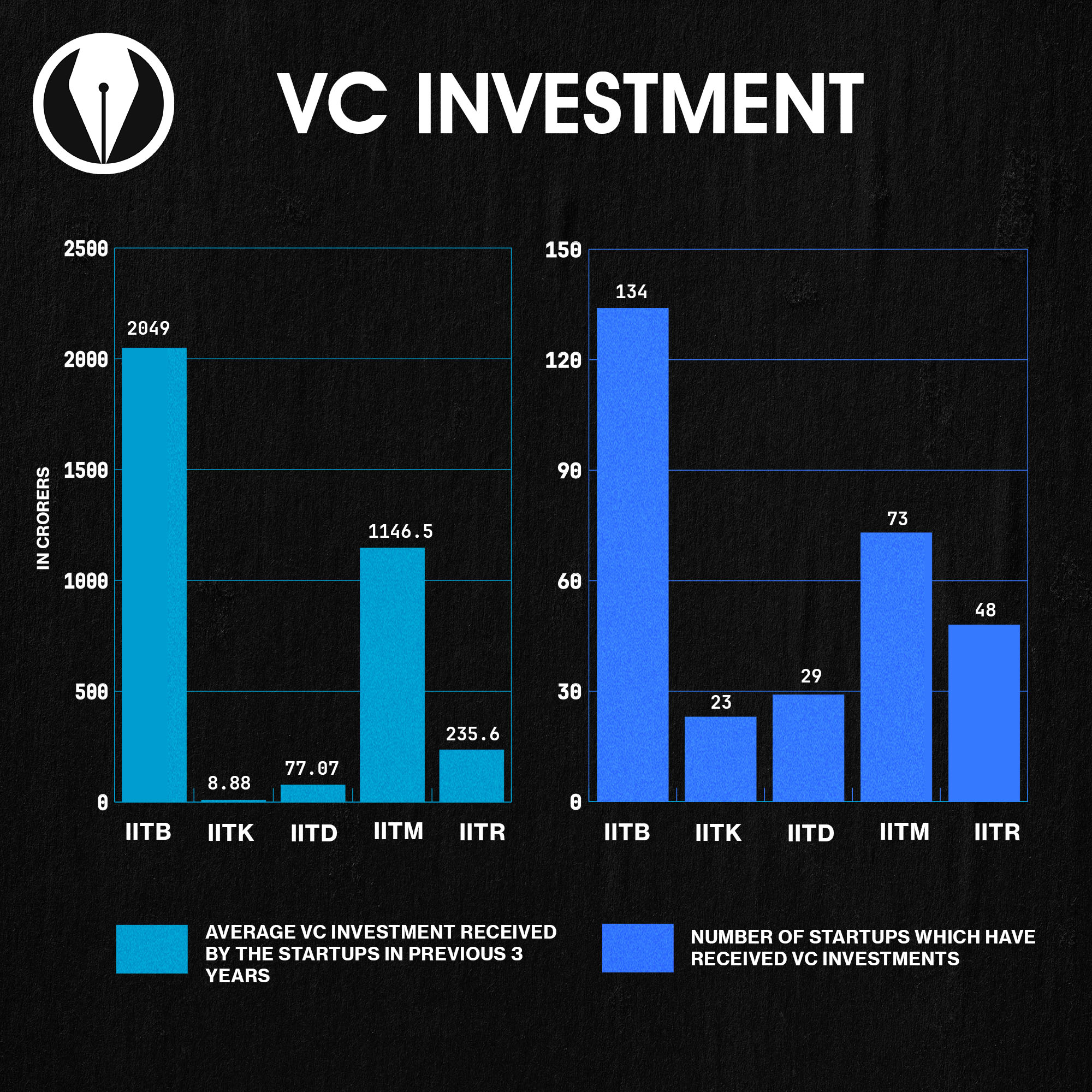
Pre-incubation and incubation are crucial for fostering startups. IIT Kanpur has its own incubation centre called SIIC. On asking about pre-incubation, “Pre-incubation is when you are preparing a startup before it becomes a company,” Prof. Bandyopadhyay explained. “I am strictly against having a pre-incubation centre at IIT Kanpur as you cannot make startups sign an agreement that guarantees they will be incubated here after pre-incubation, and without agreements to stay with IIT Kanpur for incubation, promising startups may move elsewhere, leading to a loss of potential contributions to the institute’s innovation ecosystem. I experienced this when a student of mine went to incubate at IIT Bombay after getting initial support from IIT Kanpur. Our location works against us here as well.”
Regarding the metric of credit courses offered in innovation, IIT Kanpur has no such courses for UG. “Here we are lagging”, he admitted. “IIT Bombay has an advantage in this field. They have a dedicated centre for entrepreneurship. They operate with visiting professors’ practice and have a flurry of courses on entrepreneurship. We must pick up on this. I have recently started a course in this domain. It is a 600-level course that is open to UGs as well. It’s called Healthcare Ventures and Enterprises. I expect similar initiatives to be taken in the forthcoming time.”
In conclusion, Prof. Bandyopadhyay offered his thoughts on the future of innovation at IIT Kanpur. “These rankings tend to derail the true aim of institutions, which is why I don’t fully support them. Look at BITS Pilani—their industry conversion rate is much better, and they don’t care about rankings. We should focus more on building a robust innovation culture than chasing rankings.”
He also outlined some key initiatives that could help IIT Kanpur regain its footing: “First, we need to establish an emotional connection with our startups. They should feel a sense of belonging to the incubator, which is crucial for overcoming challenges. Second, we need to attract more investment by preparing startups for pitches and improving their standards. Third, we must showcase our startups better to the outside world. Unless we strengthen these fundamentals, we can’t expect to climb the rankings again.”
CONCLUSION
In conclusion, NIRF gives a deeper insight into an institution, from teaching and graduation outcomes to research and development. While IIT Kanpur has demonstrated notable achievements in specific areas, such as maintaining a high faculty-to-student ratio and excelling in the number of students opting for higher education, there remains a need to strengthen its focus on innovation, research funding, and faculty recruitment to enhance its overall performance.
Written and Researched by: Kumar Shubham, Manya Dixit, Sanchit Arora, Yeva Gupta, Diya M, Anisha Nanda, Pailla Lavanya
Design by: Pankhuri Sachan, Srija Duruseti, Shivam Rathore
Edited by: Vedanshi Aggarwal
